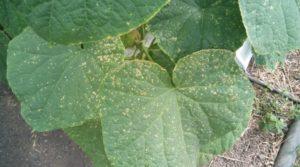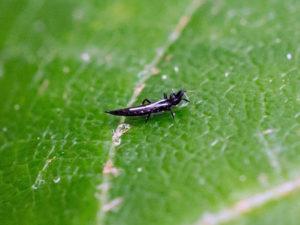Harmful insects thrips: photo and fight against them
Gardeners and indoor flower lovers know that the fight for their health is not an easy task. Especially when it comes to small pests. These are thrips - a whole squad of various pests that harm flowers and vegetables.
Content
What thrips look like: photo
Description of the pest
Name: Thrips or vesicles
Latin: ThysanopteraClass: Insects - Insecta
Squad: Thrips - Thysanoptera
 | Habitats: | garden and vegetable garden, greenhouses |
 | Dangerous for: | indoor plants, vegetables |
 | Means of destruction: | traps, insecticides |
Thrips are small omnivorous insects. Depending on the species, the dimensions can vary from 0,05 cm to 1,4 cm. The body is brown or dark gray.
| Mouth | Mouth apparatus piercing-sucking, asymmetric. |
| Legs | Running, without claws, with teeth and suckers. |
| Abdomen | Segmented, 11 parts. |
| Wings | Small, with fringe at the ends. |
Life cycle
The entire life cycle of an insect consists of 5 stages: eggs, larvae, pronymphs, nymphs and adults. In warm summer it takes 5 weeks, in favorable conditions of greenhouses and in the house - all year round.
They are deposited on the underside of the sheet, at a time there can be up to 70 of them.
Through the punctures they feed on the juice of the plant. They do not have wings, the color is whitish.
Small, asexual individuals that feed on plant sap.
They live about 45 days. Depending on the species, they can be with or without wings.
Features of behavior
Thrips live in colonies, can exist almost imperceptibly for a long time on one plant. There are behaviors:
- in the colony, they can show social behavior - to protect egg laying and colonies;
- in order to coordinate the movement of the colonies, they leave traces of a specific smell.
What are thrips
There are a lot of representatives of the thrips squad. They are mostly pests. Some are even considered quarantine, carrying various viruses that cause diseases of flowers, horticultural crops and vegetables.
How to detect thrips on a plant
Due to their small size and stealth, it can be very difficult to detect thrips in the first stages of infection. They infect the plant with punctures, slowly sucking out its juices. You can find it in several ways:
- Shrinkage and death of plant tissues.
- Small dots and holes on the leaves.
- Deformation of flowers and shedding of pollen.
- Shake a leaf or flower over a sheet of paper.
- A piece of apple or cucumber can serve as bait.
- With a large infection can be found on the back of the sheet.
With a large infection, the leaves on the plants become discolored, the flowers fall, pollen spills out and the shoots are bent.
How to deal with thrips
Depending on the localization, the methods of struggle may differ. On indoor plants, sparing methods are chosen; in a greenhouse, care must be taken to destroy insects even in the most inconspicuous places.
But there are a few general methods that are effective.
Folk methods
These are methods that are based on the use of plant parts, various decoctions and tinctures. But they are effective in the early stages of infection, they are used in greenhouses. Here are some recipes.
| Preparation | Using |
| Onion or garlic | For 1 tsp. you need to use 1 tbsp. water, insist liter. Strain before spraying. |
| Marigold | A full jar of 0,5 is stuffed with dry flowers and poured with water to the brim. Insist 2 days. |
| Dandelions | For 50 grams of roots and leaves, you need 1 liter of warm water. Insist 3 hours. |
| pharmaceutical camomile | 100 grams of raw materials must be poured with a liter of water. Cool, strain, spray. |
| Plant | Tomato or potato will do. For a glass of water you need 50 grams of dry raw materials. |
| Celandine | 100 grams of dry or 50 grams of fresh per liter of water, leave for XNUMX hours. |
| Turpentine | A little under a bush or in indoor flowers. Cover with package. |
Biological methods
These are control methods that help regulate the number of insects. This will help:
- Entomopathogenic fungi Boveria Bassi.
- Predatory mites or photoseids.
- Hymenoptera parasites.
They are specially purchased and settled on the site in order to reduce the number in the garden. On indoor flowers, this method does not apply.
Chemicals
Systemic enteric-contact insecticides will help to cope with hordes of thrips of different species. There are a number of processing rules:
- Use strictly according to the instructions.
- Do two sprays, they are not effective at the egg stage.
- Change drugs, because pests quickly get used to the action.
- Do not apply before harvest.
The following means are used:
- Alatar;
- Aktara;
- Spark;
- Fitoverm;
- Agravertin;
- Vertimek;
- You decide;
- Intavir;
- Karbofos;
- Karate;
- Spintor;
- Mospilan.
Chemistry in the greenhouse
A good remedy for mass infection with thrips in a greenhouse or conservatory is fumigation with smoke bombs. The smoke contains nicotine, which negatively affects insects, but accelerates the growth and development of plants.
You need to spend 2 times a month or every 10-12 days. Smoke only kills larvae and adult thrips.
Special traps
A fairly simple method that will help get rid of a small number of pests and monitor their appearance is pheromone traps. Moreover, they will be effective not only from thrips, but also from other types of pests. These are traps that can be of two types.
Preventive measures
Proper growing conditions will help keep plants healthy in the garden, in the garden, in the greenhouse or at home. Compliance with agricultural technology is the first and most important condition for prevention.
- In a greenhouse or room, care must be taken to ensure that there is no excessive dryness.
- Periodically arrange a shower for flowers and plants.
- Avoid stagnant moisture, excessive watering and too high humidity.
- Before planting the plant, disinfect the soil and observe quarantine.
- Dig up the soil, respect the neighborhood and swap places.
- Remove weed residues in autumn and weeds during the season.
- When the first signs of infection appear on the plant, remove the damage.
- Conduct inspections regularly.
Conclusion
Small nimble thrips can quickly destroy almost any crop. They are picky and, depending on the species, can quickly destroy certain plants. The fight against them must be carried out even at the stage of planting plants and preparing the soil.
Previous
